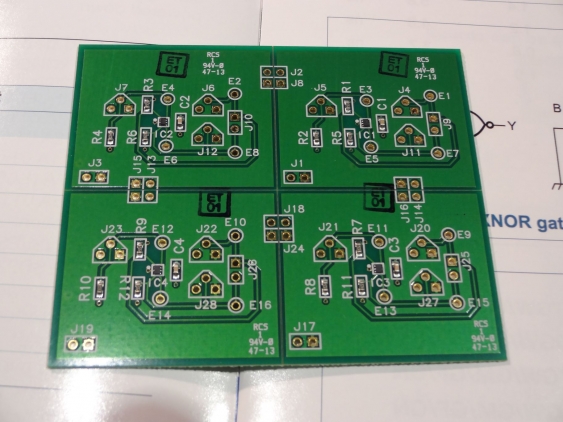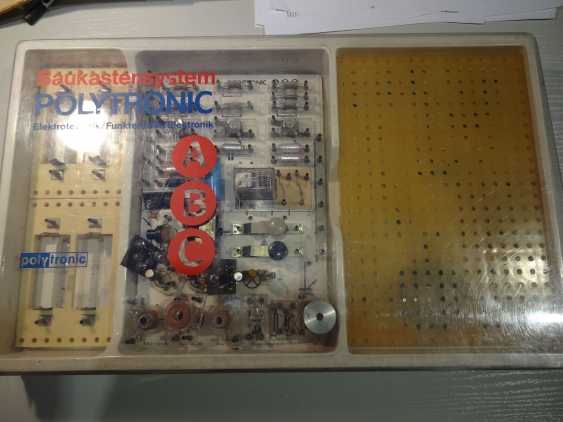20 items are tagged with contests:
wireless power - status update 2
So what happened in the last two weeks? As already mentioned, I finalized the PCB and send it away. I did go with Würth in the end. They were not the cheapest of the lot, but provided the most bang for the buck. I got 5 day manufacturing time (and since they deliver with courier, probably even from Germany, delivery also takes only one day). Also, they did not charge extra for silkscreen or solder resist (as may happen with cheaper manufacturers). And last but not least I got Ni/Au plating for still the same price, which is not only better for long-term usage, but also better than HASL for SMD soldering. So I send the board files off to WEdirekt (no need to convert them to Gerbers), and thanks to Simon Leuz I even got a 10 percent rebate
Continue readingWireless Power - the full schematic explained
Since the contest is now nearing its completion, I gather its about time to actually show and explain the whole circuit. I already went through some of the parts of it, and how I decided how to build it. But I never showed how these parts work together. So lets have a look.
Continue readingwireless power - status update
So the last couple of weeks was silent with regards to my project - I was just too busy. Being on a business trip left not so much time for doing electronic projects (and I forgot to take the Eagle project with me). And the aftermath was then rather busy at work.
But I got new transmitter coils from Würth in the mean time, and did some experiments with them (which need a write-up).
Apart from that I have finalized my schematic, and added all the missing details I already explained the most important parts of it, but there are still some minor tweaks here and there. So there will be a separate post about it.
Continue readingwireless power - battery under-voltage lockout with multiple cells
When designing systems powered by rechargeable batteries, especially LiIon batteries, its important to ensure that the batteries are not discharged too much. For primary cells this is not a problem (except that the device won’t work anymore), but secondary cells can be permanently damaged by such a deep discharge. normally this just results in permanently reduced capacity (which is bad enough). But a LiIon battery that has been discharged too deep can actually catch fire (that happens when its charged again, since during discharge internal shorts can form inside the battery). So an under-voltage safety mechanism has to be used to ensure that never happens. Basically all single cell LiIon batteries already come with such a circuit (most times inside the case already). Many battery packs too come with it, but especially pack for RC models do not, since the high current there make that difficult. A typical cut-off voltage is about 2.5 V, sometimes as low as 2.3 V. That is a voltage where the capacity might be permanently reduced already. So I would like to have the cut-off voltage higher, at about 2.9-3.0 V. That means building my own under-voltage-lockout (or UVLO)
Such a safety mechanism gets a little bit more complicated in the case of a battery pack, since there the cut-off needs to happen when just one cell gets discharged below this voltage. So lets look how we might implement that.
Continue readingAXP configurable logic design contest wrapup
So its time to finalize my project for the AXP Logic design contest. After having looked at the evaluation board, explained the electronic circuit as well as how I build the rest of the project, the last part the rules are calling for is a small essay describing my experiences with the AXP logic gates, the evaluation board and the project in general.
Continue readingHow to build a "most useless machine"
As promised last time, this article is about finally building the most useless machine of them all. When explaining the electronic / logic side of this project, I already talked a little bit about how it works. But now its time for some details.
The basic idea is rather simple: there a motor, connected to an arm. On the outside of the enclosure is a switch, which turns the motor on. The arm then moves the switch into its original position, and returns into the enclosure afterwards:
Continue readingTwo times is not enough - Measuring the performance of the wireless power demo kit part 3
Wuerth Elektronik was so kind to provide me with some additional coils to be used with Qi-compatible transmitters (and receivers). I actually asked, when receiving he offer, just for a specific one. But someone at Wuerth thought it might be better to send two for every single one they have in stock (which is four different types).
So now I have to decide which one is suited best for my purposes - and that means another round of measurements…
Continue readingTwo times is not enough - Measuring the performance of the wireless power demo kit part 3
Wuerth Elektronik was so kind to provide me with some additional coils to be used with Qi-compatible transmitters (and receivers). I actually asked, when receiving he offer, just for a specific one. But someone at Wuerth thought it might be better to send two for every single one they have in stock (which is four different types).
So now I have to decide which one is suited best for my purposes - and that means another round of measurements…
Continue readingWireless power contest - strategies for charging a battery pack, part 3
In the first two parts of my wire less power contest series I had a look at options how to handle the charging of a battery pack. Either by dividing it into single cells or using a cell balancing solution. But I always supposed that there is a charge controller doing the important part of controlling charge current and end-of-charge termination. Now its time to look at this piece of the puzzle.
Continue readingHow to design a "most useless machine" with some logic gates
So it really took me a long time to come up with the (hopefully…) final design for such a useless machine. Having some basic conditions for what parts to use for this project influenced many decisions, and made some things more complicated than originally planned. So lets have a deeper look into my solution.
First, I will explain what I used for this project, and how this shaped my decisions (and what problems arose from that). Next I will go through the whole schematic, explaining section by section my design. And last but not least I will show briefly how all of this looks in real life.
Continue readingWireless power contest - strategies for charging a battery pack, part 2
In the last part of my wire less power contest article I had a look at options for charging a battery pack by dividing it into single cells for charging. Since all the options proved to be too complicated for my purposes, I will take a look at how to charge the battery pack at once.
Continue readingWireless power contest - strategies for charging a battery pack, part1
When deciding for my basic plan to use a LiIon battery pack, I already knew that charging a LiIon battery pack will probably be the biggest challenge right now. So now it gets time for looking deeper into the issues of that problem.
Continue readingWireless power contest - outlining the basic plan
After I changed plans for last week, and did a second round of measurements, its now about time to write a little bit more about the actual project.
The basic idea is to augment an existing RC car by removing its battery pack, and to replace it with a Li-Ion battery. This battery then should get charged by wireless power transfer. Then its enough for my son to just take the car, put it on the charger station before going to sleep, and it should be ready the next day.
Continue readingMeasuring the performance of the wireless power demo kit - an update
When measuring the performance of the wireless power demo kit, I forgot to look at the efficiency. So I repeated my test series, but also measured the current consumption of the transmitter board.
I also ordered a cheap Qi receiver off eBay. Since my son has more than just a single toy I intended it to be used for other ones. Since it comes from China I did not expect to it get before a month or so, but shipping was really fast this time. So I found it in my mail on Thursday, and added it to the test series.
Continue readingMeasuring the performance of the wireless power demo kit
When talking about wireless charging, one of the questions that always come up is: what are the distances this will work for? I did answer this question already for another wireless charging kit, so I was curious what the Qi (or WPC) standard had ins store.
I’m interested in the maximum distance that is suitable for transferring a significant amount of power. Especially I wanted to know how well the transmit and receive coils need to be aligned with each other. After all, we are talking about a kid and its toys - one cannot expect millimeter precision when trying to charge to a toy over night.
Continue readingAXP1G57 configurable logic demo board - first impressions
So the evaluation board from NXP has arrived safely. Its larger than I expected (about 7.5 by 6 cm) - because its four boards in one:
Each of the four parts of the board contains a single 74AXP1G57 chip (the really small blob in the middle), surrounded by connectors to all pins, and the needed passive components (and even some more).
Continue readingUnboxing the Wireless power demo kit - first impressions
So Würth was really fast with sending the Wireless power demo kit - one of the advantages of living in Germany :)
This is what I found after opening the package:
If you look closely, you see the small tweezers on the right. Indeed - more than I expected from a demo kit…
Continue readingAnother month, another contest - gimme wireless power!
Sometimes my timing is just bad. When I applied for the AXP configurable logic contest end of last year, I didn’t know that there would be another contest waiting for me. But when I stumbled on the Beyond the phone challenge by Element14, I could not resist to register for that too. It falls into my “I always wanted to do that” category…
When I started adding wireless charging to my sons night light, I already knew that this would be useful for other toys too. So this contest was the perfect excuse to start working on that. And there was even the perfect object to be modified:
Continue readingAnother year, another contest
Since already have way to many project on my waiting list, I participate less in design contests than I used to. (I didn’t even come around to describe the projects I already did for them).
So when I stumble over one, I look whether it sound interesting or not. Sometimes there are interesting prices (I still need a decent scope beside my iMSO104), sometimes the idea is just fun (like for the last one). Sometimes the contest theme hits a nerve and its something I always wanted to play with.
When NXP informed me about their new “AXP logic design contest”, I was wondering in which category I should put it. The prices where not really for geeks of electronics engineers. And Doing something useful with just four configurable logic gates?
Continue readingOld memories, old electronics kit and a new contest
I started my career in electronics (just a private one…) when I was a kid, more than 20 years ago. Growing up in East Germany meant that possibilities and access to e.g. components or tools were rather limited. One of the most useful items for learnings was an electronics kit which I used for many experiments, and which was and important tool to gather an understanding of what’s happening in an electronic circuit.
So I was really delighted when I found, several months ago, this electronics experimenters set on my parents attic (while cleaning out some of my old stuff still stored there):
Continue reading


